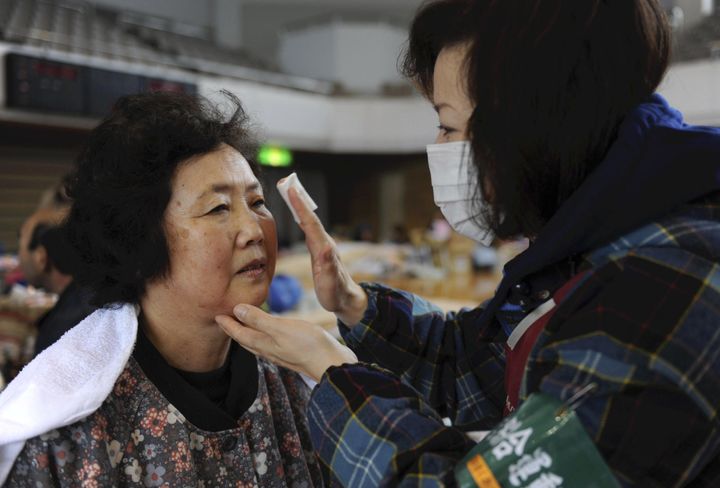
In Tome, Miyagi, a northern Japanese city about 45 minutes inland from the ravaged coastline, a group of Tokyo college students was crying.
The six had spent the last five days sorting children’s clothing and cleaning the muddied frames of photographs they’d collected from Minamisanriku, a coastal town an hour east that was one of the worst hit by the March 11 tsunami. The work was emotionally draining: cleaning images of smiling brides and grooms and sorting socks for tiny children, all the while knowing that thousands of this town’s residents have died and 10,000 were initially declared missing.
Yet the students were crying for a different reason: They were overwhelmingly proud of their day’s work.
“They said they were crying because they’ve never been such a good team,” said Kentaro Watari, who was on the other end of the phone line in Tokyo where his organization, Youth for 3.11, is working to send hundreds of students north for one-week volunteer shifts. “They’d never worked together as well as they had today. It’s a life changing situation.”
It’s also a generation-defining moment, one that Japanese youth appear to be capturing. As increasing numbers are turning to service in the wake of the worst crisis to hit post-war Japan, they’re discovering that volunteering and fundraising are not only ways to help rebuild the devastated north -- they are also opportunities to reinvent the generation’s often-maligned identity.
“Students are enthusiastically trying to organize volunteer groups and build connections between places and organizations, and those are things worth respecting from the adult’s viewpoint,” said Akiko Karaki, a senior in the International Christian University in Tokyo, who took a week off from her studies to volunteer in the north.
Most adults in the community were supportive of her decision, though some were baffled. Student volunteering is rare in Japan -- an undervalued activity that has no place, for example, on a college application.
“University people, they were surprised,” said Karaki. “They kept saying, ‘Are you sure? Are you really going?’”
The disbelief wasn’t entirely unwarranted. The absence of a strong service culture in Japan, combined with the widespread perception of the youth as lazy and spoiled, makes this current movement all the more significant. Few expected much from the so-called video game set, often criticized for being self-indulgent, aimless and passive -- for lacking konjo, the fighting spirit that helped former generations rebuilt Japan after WWII.
“This is a generation that didn’t have a clear goal,” said Mike Green, Japan Chair and senior adviser for the Center for Strategic and International Studies. “The criticism is that they are un-ambitious, lazy and insular,” he said.
Yet soon after the tsunami, images emerged of teenagers, bent double, carrying elders on their backs. Money began flooding in from fundraisers held by Japanese students studying in the United States and abroad. Twitter and Facebook exploded with students organizing teams of volunteers headed north.
Many hope that this activity will become the legacy of this generation.
“Youth for 3.11's number one vision is to do the best we can for the relief victims,” said Watari. “But our secondary mission is to create a student movement that will change volunteering and youth in Japan. Our generation has been hated on by a lot of society, and I think that after the earthquake students have woken up and realized there’s more to life, that we can make a big difference.”
Japanese youth living abroad are also finding themselves drawn to service, empowered by the possibilities of its long-term impact -- both for the country and for their reputation.
“There’s been a lot of criticism of the youth, and my father is one of them,” said Kazu Koyama, a junior at George Washington University and president of the Japanese American Student Union of D.C., which planned a massive event that raised thousands of dollars and drew high-profile attendees, including the Japanese ambassador.
“‘Oh the young generation,’ they say, ‘Is not as hard working, not as diligent.’ I would always get that message from my parents and my grandparents. I think this earthquake and our reaction really defies this view and proves that it’s not the case,” Koyama said.
Even before the tsunami, the Japanese youth were far more nuanced than the criticism would suggest. The country is overwhelmingly populated by elders: Japan has the world’s second oldest population (after retirement-haven Monaco) and more than 50,000 centenarians. Perhaps even more stifling, older generation’s accomplishments still dominate the national conscience. Today’s grandparents rebuilt after WWII; the parents built the nation into a world leader. What could the children do to compete?
Indeed, current youth were unsure about what their contribution to Japan could be. A depressed economic landscape and changed social norms of marriage and women’s roles turned their twenties into a period of indecision and aimlessness. Women chose not to marry as early; both men and women drifted in and out of short, part-time jobs.
“It’s a generation that seems lost because the expectations about what society and companies can give them has changed,” said Green.
As a result, some adults are willing to give kids a break.
“I do not agree with the characterization that Japanese youth are lazy and spoiled at all,” said Yuka Uchida, an international affairs commentator and former political secretary for Foreign Minister Seiji Maehara. “They are a hard working and serious generation, facing harder employment conditions—many facing unemployment.”
Still, students have felt the weight of the criticism regardless of the underlying economic and social forces, and they are hopeful that their time to step up has finally arrived.
“I don’t mean to say that the crisis is positive; of course it’s disastrous,” said Kenji Hayakawa, a Tokyo resident attending University of British Columbia in Canada.
Yet he views it as an alarm clock that jolted the youth awake and provided a new chance to define the future of Japan--if the generation can get organized. “What’s missing is a group of culturally prominent figures,” he said. “What we need is a younger figure who has an educational background and can voice a new attitude.”
Other, perhaps more Twitter-inclined, activists don’t think that today’s world still requires a charismatic symbol with an ironclad agenda. They believe that a sustained grassroots model centered on service will be enough to take the country in a new direction.
“Years down the line, I don’t know exactly what Youth for 3.11 will look like,” admitted Watari. “But if we have tens of thousands of students working, the possibilities are endless.”
